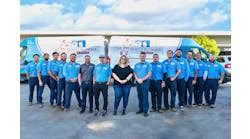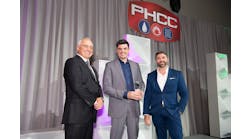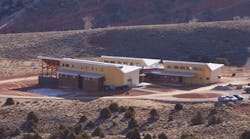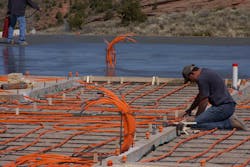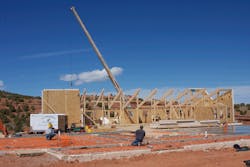LANDER, WYO. — The 911 operator remains calm through the frantic call for help — a mountain lion has mauled a biker deep in the canyon, 13 miles from the nearest town. The caller is sobbing. An hour later, the sound of an incoming MedEvac chopper reverberates off sheer mountain walls.
Fortunately, the call, the mauling, and even the helicopter’s landing in a remote mountain meadow are just a training exercise. But the location and the remoteness of this facility is real in every way. The place is the National Outdoor Leadership School (NOLS) Wyss Wilderness Medicine campus, located near Lander, Wyo. It’s where the rugged “Green Beret” of emergency mountain medicine go to hone their skills in wilderness medicine, first aid and survival.
The Wyss campus lies at the base of the Wind River Mountains far from civilization. The setting adds measurably to the experience and quality of training. Though more than 16,000 students receive training through the NOLS Wilderness Medicine Institute each year, only about 350 are fortunate enough to experience the Wyss Campus.
Students spend one month living and learning at the LEED Platinum certified Wyss campus. Though they come to train as wilderness EMT’s they leave having experienced sustainable living in a whole new way.
Sustainable lifestyle
The Wyss campus itself is just as unique and hard-core as the training offered there. Striving for an off-grid existence, and to create self-sustaining buildings, NOLS directors worked hard to achieve LEED Platinum status, awarded in November 2013.
“Every facet of our new campus project has been aimed at sustainability,” said Shana Tarter, assistant director of NOLS Wilderness Medicine Institute.
Though they knew it would be a tall order, facility managers chose a variety of interacting technologies to minimize water and energy consumption: Phoenix composting toilets, low flow fixtures, solar PV by Sharp, solar thermal, rainwater harvesting and geo-to-radiant heat for harvesting and delivering precious BTUs.
The Wyss Campus’s 36 mounted PV solar panels meet 30% of the facility’s need for electricity, while three solar thermal arrays supply all of the domestic water for eight student housing units, the educational facility and the caretaker residence. Two more collectors reside on the south hill across from the campus, supplying energy for online communications. They’ve also employed composting toilets and 22 2,500-gal. rainwater cisterns for plant irrigation.
Green innovations
With as many as 350 students coming and going through the building over the course of a year, and with weather conditions capable of hitting extreme highs and lows, facility managers knew that they needed to make sure the heating and cooling systems were up for the challenge. That being said, one of the most important goals was to install mechanical systems that delivered comfort, yet with great efficiency and minimal environmental impact.
Managers of the new campus chose to track stringent USGBC LEED guidelines, so facility architects suggested radiant heating and cooling from the start.
“There was never any second guessing what would be our best option for the heating and cooling system,” said Tarter. “Our architects were more than confident that radiant heating and cooling would be the best solution, offering greatest efficiency and comfort, too.”
MBA Construction Co., located in Blackfoot, Idaho, was hired as the general contractor. After bringing several mechanical contractors through to examine the facility in progress, and to place bids, managers chose Mechanical Innovation, based in Idaho Falls, Idaho, whose experts estimated the job at about $100,000 – with mechanical systems designed to provide winter comfort with design temperatures of -5°F. The space cooling systems would combat summer temps of 92°F.
Phil Garner, owner of Mechanical Innovations, said this was a unique project because the campus was at such a remote location, and it was very technologically advanced for the location — there was very limited cellphone service, water and power, as well.
The mechanical project began with eight 350-ft. deep geothermal bores, drilled by Lander-based Atnip Well & Pump Services. After the geothermal pipes reached the facility, Mechanical Innovation took over.
Zone valves open and close to allow areas to be controlled individually. There are 10 hydronic floor zones and three zones dedicated for the hydronic heating coils inside heat recovery ventilators (HRVs). This allows multiple zones to call and receive the heating/cooling they need almost immediately.
System designers wanted to play it safe. So they specified two geothermal pumps, loop pumps, system pumps and air separators for redundancy in case anything fails. After all, it is a remote location.
Once the fluids enter the building, two system pumps move the solution through two water-to-water heat pumps inside the wilderness center. Their “thermal target” is a 110-gal. buffer tank. The water is then sent back into the ground for another round of geoexchange.
Radiant in the cowboy state
Beneath the concrete floors of NOLS lies 14,000 lineal feet of Watts Radiant PEX tubing. Each of the facility’s 10 zones has its own slab sensor, making it readily available to call for heated or cooled glycol to be circulated through PEX loops at any given time.
According to Wholesale Services Manager Owen Phillips, at Salt Lake City-based Lundquist Sales, a tekmar 406 microprocessor house control serves as the brains of the operation. The control continuously monitors and meets the need for radiant heating or cooling fluid circulation temperatures. The device also offers web-monitoring of all environmental functions as well.
Each of the facility’s 10 zones are served by a tekmar 557 digital thermostat. The smart t-stats monitor humidity, temperature and other trigger-points, feeding information continuously to the 406. The 406 opens and closes zone valves and governs all geothermal system operations with indoor feedback to operate heating system functions at the lowest operating temperatures to maximize efficiency.
“In the cooling mode, the 406 performs the same function, only in the opposite direction,” added Phillips. “All cooling needs are met with the highest possible operating temperatures, and smooth system operation. No sense using cooler fluid temperatures than are needed to get the job accomplished.”
According to Phillips, the key need during the cooling season, by design, and met precisely by the controls, is the ability to monitor ambient dew point, controlling circulated fluid temps through the in-floor loops to stay just two degrees above temperatures at which condensate would form.
This was also a unique project because Mechanical Innovations hadn’t worked on many jobs with the new technology that adjusted the cooling based off of dew point temperature, said Garner.
“The radiant heating and cooling operate and provide year-round comfort far better than we expected,” said Ron McCall, Wyss Campus Facility manager. “At first I was a little skeptical, but I’ve come to love the system. Building spaces are extremely comfortable, no matter what time of year.”
“We use Watts for every radiant job we get,” explained Garner. “We especially like that we can order spools of PEX 1,200 feet in length.”
Mechanical Innovation also used Watts’ stainless steel pre-manufactured recess boxes to cover up the manifolds, with pressure and temp gauges, as well as individual loop control with ball valves for isolation.
